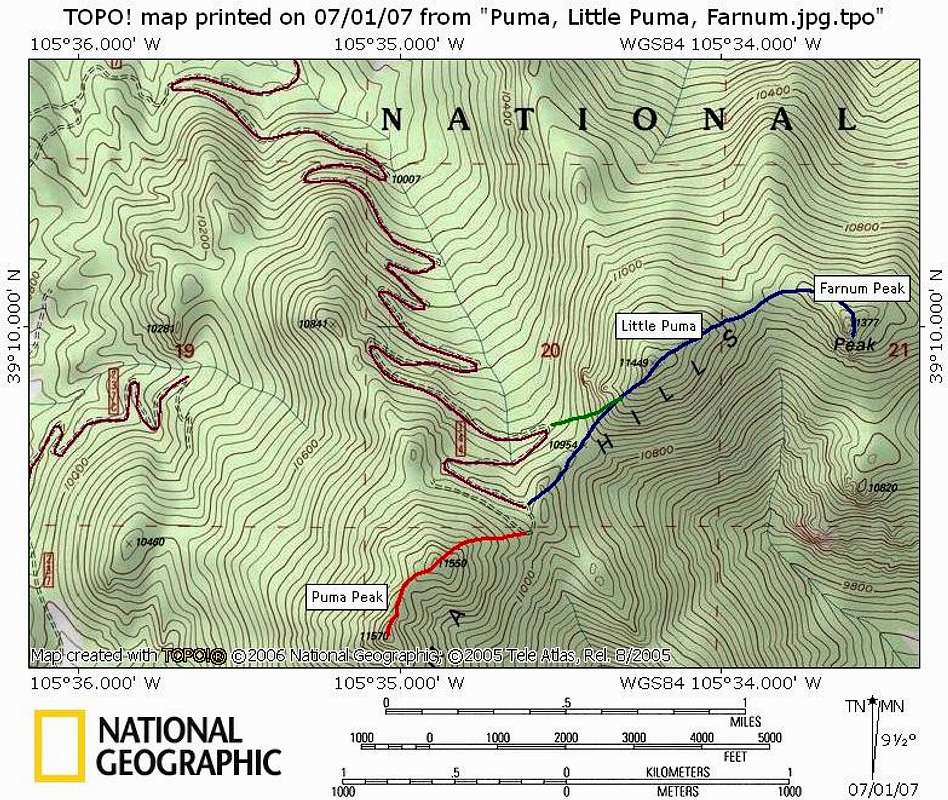-
 2926 Hits
2926 Hits
-
 72.08% Score
72.08% Score
-
 2 Votes
2 Votes
|
|
Route |
|---|---|
|
|
39.16510°N / 105.5696°W |
|
|
Hiking |
|
|
Spring, Summer, Fall |
|
|
Half a day |
|
|
Class 1 walk up, route-finding/navigation, Class 2 summit block |
|
|
Overview
Little Puma. Doesn't sound very threatening, now, does it? Sounds almost cute and fuzzy. A new respect will be gained for this mightly little mountain by the hiker making the bushwack up Little Puma's southwest side to the summit. I found myself whishing I'd worn my old soccer shinguards under my hiking socks. Confident route-finding through heavy timber and dogged perserverance will gain this secluded summit.Note: This route is only for the hiker comfortable with off-trail navigation and route-finding through dense trees. Nothing even vaguely resembling a trail is remotely visible after departing the logging road. Remember, while reaching the summit is a fairly straightforward exercise, returning safely to the trailhead can be another matter. If your idea of navigation is a half-dead GPS burried in the bottom of your pack, please opt for a well-worn trail where you can practice your skills with map & compass suplemented by GPS. Very few people visit these Puma Hills summits. If you get lost, you will be lost in a big way.
Getting There
From Colorado Springs: Hwy 24 West to Lake George. Just past lake George, turn right (northwest) on Park County 77 (Tarryall Road). Use caution with the minefields of potholes. Between dusk and dawn, deer and elk are incredibly numerous - watch your speed! Just before the Tarryall Reservoir, turn left on Park County 23 (Turner Gulch Road). Follow Park County 23 1.6 miles and turn left onto FS 144. Take FS (Forest Service Road) 144 4.5 miles to the junction with FS 237. Bear left/east at this junction and continue until a parking area where the road makes a sharp right, crosses a stream (Pack Creek) and heads into deep woods. There is no sign for this trailhead. Parking is ample with respect to the small volume of fellow trail users.From Denver: Take Hwy 285 to the town of Jefferson and turn left on Park County 77 to the Tarryall Reservoir. (Keep an eye out for free range cattle.) Just southeast of the reservoir turn right on Park County 23 (Turner Gulch Road). Follow Park County 23 1.6 miles and turn left onto FS 144. Take FS (Forest Service Road) 144 4.5 miles to the junction with FS 237. Bear left/east at this junction and continue until a parking area where the road makes a sharp right, crosses a stream (Pack Creek) and heads into deep woods. There is no sign for this trailhead. Parking is ample with respect to the small volume of fellow trail users.
Route Description
Approximately round trip mileage: 6 milesApproximate elevation gain: 1,750 feet
This route description is approximate and is meant to compliment a detailed topgraphical map. Nothing can compensate for your own, well-honed navigation skills, aided by map & compass and GPS.
- From the unsigned Packer Gulch trailhead at 9,700 feet, continue by foot on FS 144 west across Pack Creek into the woods.
- Follow FS 144, switchback after switchback, for approximately 2.5 miles.
- The road ends at the summit of the saddle between Puma Peak and Little Puma Peak.
- Turn northeast and begin the bushwack to the summit of Little Puma. (A rock outcropping will be encountered shortly after departing the loggin road and can be easily bybassed.)
- Stick to this southwest-facing ridge, pushing your way over rocks and downed logs. Scan for the path of least resistence without losing focus on your goal.
- You'll know the high point when you see it.
- Scamper up the summit rocks and have a seat. The views, while not wide-open 360 degrees, are better than may be anticipated.
Essential Gear
For safety and comfort, the following are recommended:- Long pants. I strongly recommend against shorts for this hike through deep woods and fallen timber over a rocky slope.
- Topographic map
- Compass
- GPS
- Colorado Atlas and Gazetteer (for backroad navigation)
- Trekking pole(s)
- Sturdy hiking boots with grippy soles and stiff ankle support
- More water than you think you will need (these are dry mountains)
- First aid kit
- Other standard backcountry essentials (if I have to list these for you here, you probably should not navigate trail-less summits)
Map
The below topo map illustrates routes from the saddle summit of FS 144 to:Puma Peak, 11,570 ft -- Red
Little Puma Peak 11,449 ft -- Blue = primary route; Green = shortcut (easy to use going up, but tough to nail on the return)
Farnum Peak -- Blue

External Links
Pike & San Isabel National ForestsPike National Forest Recreation Map

